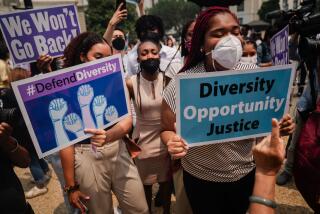Op-Ed: In the U.S., diversity is the new majority
A just-released Census Bureau report shows that by 2044, whites will no longer comprise a racial majority in the United States. By then, the nation — like today’s Los Angeles — will be made up of a kaleidoscope of racial groups, including Latinos, blacks, Asians, Native Americans and multiracial Americans.
This “no racial majority” scenario, even three decades away, provokes fear in some white Americans: fear of change, of losing privileged status or of unwanted people coming into their communities. But it is a change that should be welcomed.
The fact is that “no majority” America is here and thriving in 2015. According to the new projections, it is here among children younger than 5, and it is here among all students in the nation’s public schools. It will be here for the nation’s under-30 population in less than a decade, deepening the transformation that has already come to pockets of many urban cores and large swaths of the nation’s coasts and the Southwest.
Interracial marriages are at an all-time high, especially among the young and especially in the most diverse sections of the country. And in just 16 years, there will be minority white populations in 12 states, including California (Los Angeles crossed this threshold in 1990), Texas, Florida, New York, Georgia and New Jersey, according to a recently released States of Change project report that I wrote with Ruy Teixeira and Robert Griffin.
Fear of a racially diverse nation seems to be greatest in parts of the population and the country that have yet to experience this change. These include a slew of communities and states that have recently enacted laws tough on immigrants in the country illegally even though relatively few immigrants live there, legally or illegally. In the broader population, fear is greatest among the least-diverse age groups — baby boomers and seniors, many of whom grew up in an era of low immigration and extreme segregation and interacted less with minority populations.
A 2011 Pew Research Center survey indicates that older Americans are more resistant than the population as a whole to new waves of immigrants: More than half of all white baby boomers and seniors believe that the growing number of newcomers from other countries represents a threat to traditional values and customs. More than 4 in 10 white seniors said a growing population of immigrants is a “change for the worse.”
Attitudes like theirs are hardly a new phenomenon. They were evident in the sometimes violent backlashes against Asian and white ethnic European immigrants who arrived in the 19th and early 20th centuries, and in the post-World War II practice of “blockbusting,” in which real estate agents tried to scare white homeowners into selling at a loss by hinting that black families would move into their neighborhoods. Yet fear eventually subsided as the tide of demography led to greater familiarity and acceptance.
Today’s diversity boom is one of these tides, and it is a godsend, occurring just in time to counterbalance the aging of our white population. The new census projections show that the white population, now slowly growing, will begin to decline steadily after 2025, as the number of white women in their high fertility years drops, and deaths outpace births for decades to come.
Over the next 15 years, the entire under-65 white population will begin to get smaller. At the same time, the younger part of the U.S. population is growing entirely because the numbers of racial minorities, especially Latinos, are rising. In a change, the primary driver of growth in the Latino population isn’t immigration. It’s the number of births to Latino U.S. residents.
This growth gives the U.S. a chance to avert the problems of a stagnating and aging population, which Japan, Italy and other European nations are already facing. We are gaining a competitive advantage, and our priority should be to integrate immigrant and native-born minorities and prepare younger members of minority groups for success. At all levels of government, we should help provide young families and their children with the education and social services they need to be productive members of the middle class.
Achieving this will require countering fear of the unknown, especially among older whites, the only part of the white population that is projected to increase, and the one that votes. They need to be made aware that this dramatic demographic transformation is underway, and that it will benefit them. Investments in younger minorities — whom they may not yet see as their children and grandchildren — are crucial not only to the success of the nation’s economy but also to future contributions to government programs like Social Security and Medicare.
With enlightened leadership, I believe they will come to realize this, and to support investments in our growing youthful minorities. We are, after all, a nation of immigrants, people who share a sense of inclusiveness despite flare-ups of racial tension. Guarding the welfare of today’s diverse young families is in everyone’s interest — so all of us can prosper.
William H. Frey is a demographer and senior fellow with the Metropolitan Policy Program at the Brookings Institution and author of “Diversity Explosion: How New Racial Demographics Are Remaking America.”
Follow the Opinion section on Twitter @latimesopinion and Facebook
More to Read
A cure for the common opinion
Get thought-provoking perspectives with our weekly newsletter.
You may occasionally receive promotional content from the Los Angeles Times.










